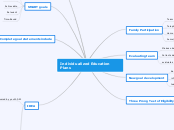Individualized Education Plans
Family Participation
Team meetings
Telephone calls
Home visits
home/school communication
Evaluating team
Makes observations
Collects data
evaluates goals
New goal development
based on prior conversations with families
information from present levels of performance
teachers come prepared with Ideas for new goals
Three Prong Test of Eligibility
State eligibility requirements
adverse impact on educational performance
Need for specially designed instruction
Five components of IEP goal
Condition
Target Skill or Behavior
Criteria
Procedure
Schedule
SMART goals
Specific
Measurable
Achievable
Relevant
Time-Bound
Complete goal statements include
Student Needs
Baseline Data
Annual Goals
General Education Content Standards
IDEA
13 disabilities covered by youth 3-21
Autism
Deaf-blindness
Deafness
emotional disturbance
hearing impairment
intellectual disability
multiple disabilities
orthopedic impairment
Other health impairment
Specific learning disability
speech or language impairment
traumatic brain injury
visual impairment
the term "developmental delay" can be used for age 3-9
Special services are available for eligible students
